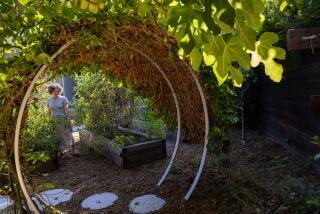Greener Pastures
- Share via
Look in the Thomas Guide and you’ll see plenty of space between the streets of Rolling Hills, a city where zoning nurtures an idyllic rural atmosphere. That means large lots, no sidewalks, street lights or corner malls and residents can keep any animals (except pigs) they like.
But when Julie Heinsheimer and her husband, Tom, bought their 2 1/2 acres in 1968, what they got was hardly pictureseque. The previous owner’s omnivorous goats had eaten all but four carob trees and one fig tree, leaving only brown stubble in their wake. If the Heinsheimers were going to enjoy the bucolic outdoors, they would have to create it themselves.
Julie, now landscape designer for the architectural office of Edward Carson Beall and Associates in Torrance, had no master plan back then, no detailed drawings or planting lists. Her only thought, she recalls, was “to maintain the open, rural feeling.” So for nearly three decades, the garden has taken shape “in fits and spurts, as time and budget allowed,” along the established animal paths and farm roads.
First, Heinshemer turned the old farm road between the house and the whitewashed barn into an allee, the old carobs providing shade on one side and a new field of bearded iris and citrus trees on the other. The idea comes right out of the south of France, her inspiration for much of what followed.
Heinsheimer terraced the area next to the house, adding olive trees with a patio underneath. Remembering from her travels in England how roses were trained into trees, she also planted ‘Lady Banks” roses beneath the olives so flowers could grow through the branches. Elsewhere along the same terrace, a border anchored by bird of paradise is packed with other plants that thrive in Southern California’s Mediterranean climate--penstemons and star clusters, oleander and lavender, sage and daylilies, plus more roses and iris. Nearby, a ‘Barbara Karst’ bougainvillea blooms vividly against the house.
An old corral adjacent to the barn was transformed into a vegetable garden and the three-rail horse fence was planted with climbing red ‘Blaze’ roses, with fragrant lavender and valerian nearby. After a winter gully-washer in 1994 carried good soil from this vegetable garden to a lower pasture, that area became a vegetable patch, too. Several French tuteurs add height and drama here, providing support for green beans and morning glories. In both gardens, which are connected by a serpentine walkway edged with rosemary, straw separates the beds and deters hungry snails.
A portion of John’s Canyon cuts across the property--right through the barn, in fact. To channel heavy rains away from the garden, Heinsheimer dug a stream bed on one side of the flood plain and lined it with rocks. A rustic bridge of weathered planks, railroad spikes and eucalyptus limbs joins the allee and an orchard of citrus on the other side.
Today, the Heinsheimers finally have their beautiful rural setting. What’s more, it’s laid out without looking the least bit contrived. Perhaps landscaping patiently--bit by bit, plant by plant, as they did--is the best way to imitate Mother Nature.
More to Read
Sign up for The Wild
We’ll help you find the best places to hike, bike and run, as well as the perfect silent spots for meditation and yoga.
You may occasionally receive promotional content from the Los Angeles Times.






